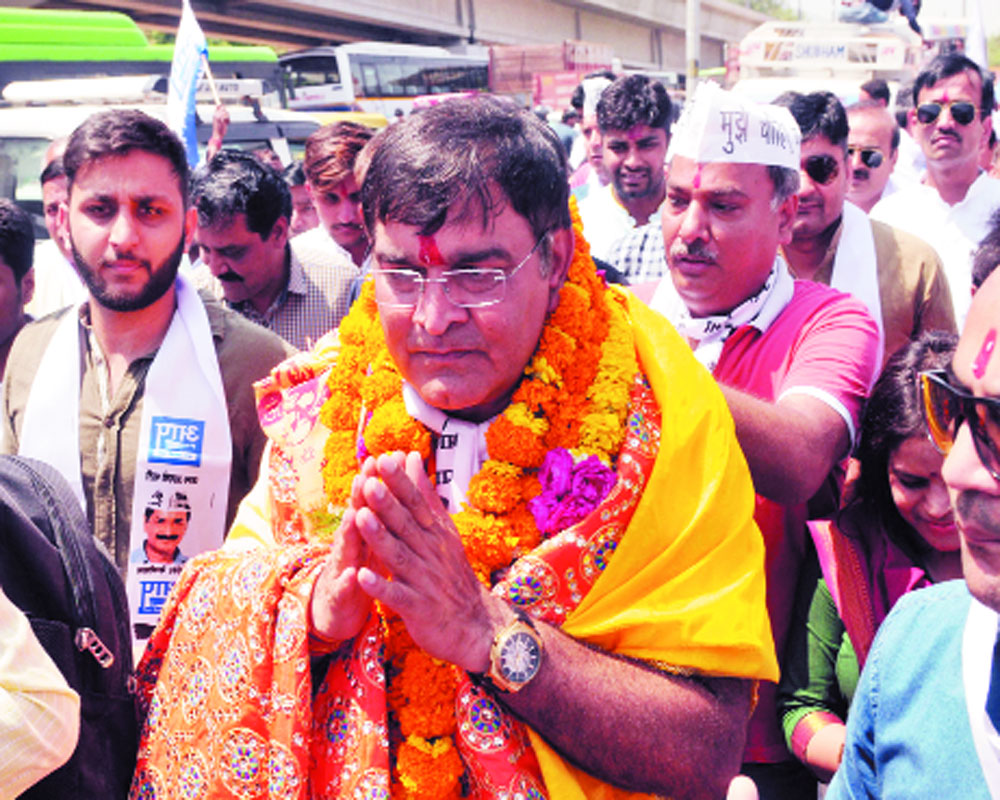Political parties in the national Capital have blamed each other for playing caste and community cards during elections but the reality is that caste affiliations of voters as well as candidates seem to play a crucial role in the Delhi politics despite the political party's campaigns hinging upon issues such as infrastructure development, price rise, water crisis and corruption. Going by the caste arithmetic in the West Delhi constituency, communities such as Jat, Gujjar, Punjabi, Sikh and Vaish continue to dominate the area's electoral fortunes.
There are two Jat candidates. They are Parvesh Varma from Bharatiya Janta Party (BJP) and Balbir Singh Jhakhar from Aam Aadmi Party (AAP) while Congress has fielded Purvanchali candidate Mahabal Mishra who had won this seat in 2009. Purvanchali, Jat, Sikh and Punjabi voters would ultimately decide the outcome.
According to political pundits, it is believed that the Jat votes may split as there are two Jat candidates. "Purvanchalis who form a formidable vote block, too, can split, mainly between Congress and BJP. Earlier, the constituency was considered to be very important for the Jats, when Sajjan Kumar, a former Congress leader, was in power. Later, Purvanchali voters became a vital part of the West Delhi seat," said a political analyst.
After the delimitation of parliamentary constituencies in 2008, West Delhi was constituted with 10 Assembly segments-Madipur, Rajouri Garden, Hari Nagar, Tilak Nagar, Janakpuri, Vikaspuri, Uttam Nagar, Dwarka, Matiala and Najafgarh.
West Delhi has a population of 25.43 lakh and a population density of 19,563 inhabitants per square kilometre. While neighbourhoods such as Dwarka, Janakpuri and Rajouri Garden are considered affluent and middle class, areas such as Madipur, Hari Nagar and Matiala are considered home to migrants and working-class families who live in unauthorised colonies whereas Najafgarh is considered as a place where one can see a glimpse of rural areas.
In 2014, BJP's Parvesh Verma won the West Delhi seat by a margin of around 2.86 lakh votes-the highest in Delhi by beating the incumbent Mahabal Mishra.
Pockets such as Rajouri Garden, Tilak Nagar, Janakpuri and Hari Nagar have a large Sikh population, while Jharoda, Dichaun Kalan, and Dhansa are Jat strongholds.
Varma, the son of former Delhi CM Sahib Singh Varma, belongs to the Jat community and the party believes it would help him win a second term but Jakhar, who also belongs to Jat community, is a native of Mitraon village in Najafgarh area in the constituency. Though Both Varma and Jhakhar does not give much weight to the caste but the reality is that the constituency which has also a strong hold of Jats in several areas may see vote division. "Earlier, AAP have attacked BJP for caste and community based politics but the party itself has fielded a Jat candidate from seat to lure Jat votes in the constituency," said a political analyst.
Whereas, Congress candidate Mishra, a migrant is banking on Purvanchali voters to repeat his 2009 performance. According to political pundits, the Purvanchali votes also divided here between Congress and BJP.
Though, the economic and cultural make of the area is varied but the demands of people are largely the same which we can see in other six Lok Sabha constituency in National Capital. The residents of Dwarka rued lack of water and connectivity in the area.
"We have to call water tankers and they cost too high. Water crisis is here in Dwarka. We will vote a candidate who will resolve our water issue," said Sudha Singh, a housewife and resident of Dwarka sector-6.
Students travelling to their institutions, whether it is Delhi University South or North Campus, IGNOU and others rued about the connectivity issues. "We get late for our classes. There is no straight metro connectivity and even DTC buses are also rarely available and if available they take a lot of time to University. My vote will go for candidate who not only assures for connectivity in the area but also make it happen," said Akarsh, a resident of Dwarka who studies at DU.
Whereas, residents of Uttam Nagar, Rajouri Garden, Tilak Nagar, Janakpuri and Hari Nagar most of whom are indulge in small scale business said that the votes here are divided among three parties, Congress, AAP and BJP.
"After the recent sealing issue in Mayapuri, the voters here are giving second thought to which candidate they should vote. People living here want that their small scale business should not be affected. Over 70 per cent people in the area have small business and that is their only sole earning for living," said Kanwal Preet Bindra, a resident of Hari Nagar.
While, in villages like Jharoda Kalan, Jhujhuli, Qazipur, which lies in Najafgarh area will vote a candidate who would give farmers priority. Though as per visit to these areas the votes were seen divided between AAP and BJP as they both have fielded Jat candidate.
"These areas are in Delhi where still farming is done. No state and centre government have ever given a thought to think about farmers in Delhi. We have electricity issues in the area for last one decade and nothing has been done so far to improve conditions," said Sachin Rathee, a resident of Jharoda Kalan village.
"Even we don't have connectivity. Najafgarh is the area which people in Delhi think is not a part of Delhi. We also feel isolated. Crimes here have spiked a lot. We want an MP who will resolve all issues here," said Rathee.
























